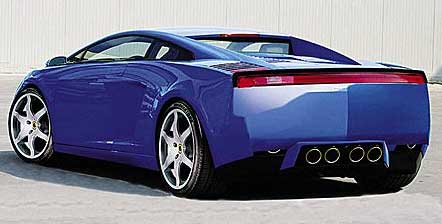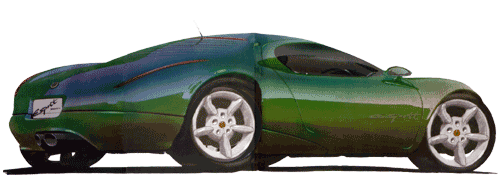

The All-New Lotus Esprit
In a privileged glimpse
behind the scenes,
Lotus engineers have given us first sight of what the
stunning new Esprit supercar will probably look like.
It's just one of a raft of visionary new designs coming out of Hethel
Autocar Magazine, February
2004
by Steve Cropley
Lotus is working at top speed to design and develop a secret new £75,000 supercar to replace the 25-year-old Esprit in two years' time. Depicted below is an official Lotus drawing and, above, enhanced by computer design, the new Esprit – a mid-engine two-door coupé with compact styling and dimensions, sophisticated aerodynamics, ultra-agile handling and a top speed close to 200mph – is being engineered to suit all the major car markets of the world. Lotus aims to offer markedly better performance and value for money than established opponents like the Porsche 911, Ferrari 360 and Lamborghini Gallardo.
Another new Hethel supercar will be launched about a year later, in 2007, to fill the price gap between the Elise and Esprit. The car is in its earliest planning stages, but is likely to be a two-plus-two front-engined coupé priced around £50,000. Though quite different in mechanical layout to the others, the coupé will share a remarkable number of its chassis components and running gear with them, using the latest Lotus technology. This new three-tier product line-up shows for the first time how Lotus plans to fulfil the forecast made last year by the company's deputy chairman, Victor Kiam, to develop Hethel as a 10,000-a-year sports car manufacturing business.
Previous Lotus expansion plans over the years have foundered on cost grounds, but Kiam and his engineers believe the difference this time is that these models will pioneer a new Lotus-developed process called Versatile Vehicle Architecture (VVA), which allows models as desperate as a front-engined four-seater and a mid-engined two-seater to share high-investment chassis parts, leading to a dramatic cut in development and manufacturing costs. The process is so flexible, say Lotus engineers, that it will eventually be adopted for all three Lotus models: the £25,000 transverse mid-engined roadster (the Elise replacement); a £50,000 front-engined two-plus-two coupé; and a £75,000, 200mph mid-engined supercar (seen here). Behind the new plans is a realisation at Hethel that the trendsetting 'tub' monocoque chassis of the Elise, made up of a light but very rigid combination of aluminium castings and extrusions, is even more versatile than its designers first realised.
'The Elise chassis design was optimised for lightness, so we compromised on ease of entry and exit,' says Richard Rackham, Lotus's chief vehicle architect. 'Buyers were so thrilled when they drove the car that they overlooked the difficulties of getting in and out of it. But when we tried to scale an Elise chassis up for bigger cars, we found it didn't work very well. More expensive cars built with the same compromises wouldn't please the buyers, we felt. So we've spent the past year finding out how to use Elise chassis principles without the other drawbacks.'
In essence, Lotus is designing intricately cast, ultralight dogleg-positioned castings at the four lower corners of a car's cabin space to connect Elise-style boxed side sections with optimised load-bearing (and crashable) structures front and rear, without reducing either door size or cabin. Richard Rackham and his team reckon they have come up with components versatile enough to work in a wide variety of vehicles: front-engined or mid-engined, transverse four to longitudinal V12, two seats or four. It's a bit like striking the chassis engineer's jackpot.
'These castings are easily the most expensive components in a chassis of this type,' says Rackham. 'We've learnt that if we design them carefully, they can be used not only in cars of disparate mechanical layout, but reused in the replacements for those vehicles in the future. A lot of our work over the past year has been about forecasting the cars we might like to build in years to come and devising chassis parts that would work in every case.' These future developments were revealed to Autocar in a roundtable meeting at Hethel last week, chaired by Lotus's UK general manager, Ansar Ali, and attended by Clive Dopson (manufacturing director), Russell Carr (head of design), Richard Rackham (head of vehicle architecture), Roger Becker (chassis development expert), Tony Shute (head of Lotus's new product team) and Rupert Williams (project engineer for the new supercar).
Two years from launch, the team was reluctant to go into too much detail about the new supercar; although much of its packaging has been decided, its 'look' is still fluid and the Norfolk engineers don't want to feed information to rivals.
Autocar's own deductions about the new mid-engined supercar and its future are as follows:
• Despite being referred to internally and by us here as the new Esprit, it will probably not use the Esprit name. The construction method will be so different and the level of design sophistication so much greater than the old car's, that the two would have little in common. 'For the time being,' said one engineer, with a smirk 'we're calling it Elvis...'
• It will use a longitudinally mounted engine, probably a forced-induction V8, mounted behind the occupants' heads, possibly supplied by Toyota. Lotus now says it 'did the deal' to use the 190bhp 1.8-litre in-line four, recently adopted for US-spec and new-generation European Elises, over two years ago, and found they still had friends at Toyota from the time, more than a decade ago, when the Japanese had a major stake in Lotus.
• Lotus may, however, eventually build its own engine for the top two models, whose volume could reach 2000-3000 a year (1000-1500 of each), though the Elise-level model will use the Toyota unit.
• The car's 1300kg weight and 1900mm width targets will make it a very agile car. Lotus is already admitting its dimensions will probably allow a return to racing for the quickest versions. The old Esprit did well in both European GT and SCCA racing well along in its career, thanks to fine handling and low weight.
• The two-seat supercar's launch is probably being planned for Geneva 2006, because the original production Esprit made its debut there in 1975.
• Package efficiency will be a higher priority in the new Lotus models than ever before. Though proud of its heritage, the modern Lotus company is sick of its reputation as a producer of cars for occupants of 5ft 7in (Colin Chapman's height). Richard Rackham has carefully tracked research into the increasing stature of sports car customers and believes one of VVA's key benefits is to improve ease of entry and egress, one of the chief criticisms of the Elise and Exige.
Russell Car has not arrived at a final shape for the new Esprit, as the variety of sketches reproduced here – some redrawn by Autocar's own artist – make clear. Carr will have to produce one within a few months. He lists the key Esprit styling components for us: the save-the-wedge shape, the flat or near-flat windscreen, the unique side-window shapes, the clean almost geometrical body sides (contrast them with the Elise's scoops and scallops), the flip-up quad headlights and the flat rear screen, with or without louvres, depending on which James Bond movie you saw. As the engineers work at designing and locating the car's main mechanical parts (one fascinating, hastily covered document we spotted in Lotus's design studio was a full-size package drawing), Carr says he has been investigating two different design approaches.

'One way is to evolve the car by theme and detail,' Carr says, 'along the same lines as the Porsche 911 or the Range Rover or new Mini. The latest models are quite different cars from their predecessors, but anyone can tell what they're supposed to be. You look at the main elements, lights and window shapes, and you know instantly. 'The other way is to let the Esprit's spirit evolve – the same way the Elise has evolved from the first Elan. They're completely different mechanically, but the Elise is definitely the kind of car likely to appeal to old Elan lovers 40 years on. There's no element of pastiche, but the car still pleases the right people.'
There's no clue from the round table as to which line is about to be adopted. Full size models from each side of the argument have been built and are being considered. But Autocar's impression is that some members of the Lotus team believe that there have been enough 'pastiche' cars, and that it would be more appropriate to do a 'spiritual' design – along with a new name – using the way the Elise replaced the original Elan as a guide.
Our Lotus panel wouldn't even say for certain whether the 'third' model, the 2007 entry, would definitely be a front-engined two-plus-two, as the Lotus sourced renderings we show here indicate. But Ansar Ali agreed that the logic was with the idea, since a slightly more sensible, liveable-with model gave Lotus buyers above and below something else to aspire to, and there were precedents from history in first the Elan Plus 2, then the Eclat/Excel range.
'It's four times more expensive to convert a Lotus buyer than to keep an existing one', says Ali, 'and part of our strategy is definitely to do a lot more repeat business in the future. The Lotus clubs say they're expecting a two-plus-two, which may be a sign that there's a latent market.'
One lesson learned from the M250 is that it was probably unwise to launch a model too close to the Elise, now so well developed. The Toyota-engined model has 15% more weight but 50% more power than the original, facts which would have made life hard for a bigger, V6-engined sibling. Better to have a brisk-performing two-plus-two between the agile roadster and the 200mph supercar. The round table soon fleshed out the M250's other shortcomings: it had very little load space, it wasn't engineered to world standards and the performance-feel of the unblown V6 engine just wasn't right for a Lotus. Live and learn.
Once again, Lotus is on the front foot. The company is on the lookout for talented people again and working on the kind of projects which have always enthused the engineers and designers who carry Colin Chapman's flame. There's a confidence at Hethel in what they've done lately: improved the Elise, given it more power and breeding, and launched it in the US. Elise annual mileages are rising as people find the cars easier to use, while warranty claims are falling. And nowadays, all things Lotus must fit the financial rules laid down by Proton's money men, Victor Kiam, who seems to be something Hethel has never previously had, a model of financial probity.
There is risk ahead. The promising US launch must translate into 1500-2000 Elise sales a year – a bit task. The Toyota-engined Elise must convert new hearts and minds in Europe. If the new supercar and GT models are to be worth building, VVA has to bring unprecedented deficiencies. And there are concerns if things get tough, such as the unavailability of development finance from Proton, which (one hears) is severely limited in its domestic market and pretty strapped for cash.
But Lotus hearts are upbeat and plans are impressive. Experienced hands like manufacturing director Clive Dopson, who designed engines before he took over production, reckons it can work. 'Roughly speaking,' he says 'it costs about as much to develop an engine as it does the rest of the car. We think we have a project that can break that relationship and take a huge amount of cost from the car. We need this car, so we can show people how well it works.'
ONE MORE LAP, FOR OLD TIME'S SAKE
The first time I ever went to Lotus, back in 1979, I did some laps of the Hethel test track with Roger Becker, Lotus chief test and development engineer, and one of the men most directly responsible for the smooth, rhythmic, unflamboyant driving style which has washed through the ages from well schooled Lotus test slivers into the cars themselves. Every Lotus, new or old, has faithful responses, a firm but supple ride, carefully balanced control efforts, lovely damping and more grip than a Jack Russell on a postman's leg.We were in an old Esprit now, in the sense that all Esprits are old now. The model has come to the end of the production line. This one was built a few months ago, but is due to be owned by the company for the next 10 years because they've got to keep a running example to show they can support owners for that period.
Becker wasn't being particularly polite about the old Esprit. Truth be told, he was being significantly ruder about it than he'd ever been during its production life. 'It's still a decent old thing.' he allowed, 'but in this day and age, it just isn't rigid enough. An Elise is something like four times as stiff, even after we made the mods we did for the Sport 300 and the S4S. You can feel it, actually. When you get near the limit, the front responses are just a little bit out of phase with the rear. That's because it flexes. It's not a big problem, but it can make you unsure of the car, just for a nanosecond.'
Becker drives as he always does. Flat out for a bit, flipping it into oversteer around some puddles lying in Circle corner on the circuit's southern outskirts, then slowing a bit and just stroking around as we talk. Still seemed a fine car to me. Driving with the Beckers of this world is fun: unusually for a driver in a car of this potential, he seems to have more in reserve than the car.
Lotus did build a rigid Esprit, Roger says – an experimental model called X140, with a perimeter chassis. It was even stiffer than an Elise. He goes a bit coy about what actually happened to it – for reasons I can guess. X140's extra alertness and sharper responses will be used to define the new Lotus supercar, the one for 2006, whose chassis really will be rigid. So we drive back to the pits and I don't talk much more to Roger about the old Esprit. He has other things on his mind.
The Last Esprit
As you read this, Lotus is putting the finishing touches to its last-ever Esprit, a smart yellow V8, which will soon be on its way to a hand-picked US owner, a man who already has a handsome collection of Lotuses. Everyone says it's the end of an era, except Brian Angus who, as Lotus's Esprit platform manager has at least 10 years' work ahead of him, providing back-up for the 10,000-odd Esprits built since 1975, when the production model made its debut at the Paris Motor Show.
Angus came to Hethel more than 20 years ago, hired by Colin Chapman from the aero engines side of Rolls-Royce, where he was the self-confessed world expert of turbine blade fatigue testing. 'It was interesting, but only for about 20 minutes,' Angus says, 'so I came here and I've never regretted it.' Nobody knows more than Brian Angus about Lotus Esprits, their care and grooming, because he has worked continuously on them all the way. His favourite model, he says, is the S4S for its power, thorough re-editing of the chassis and the durability of its 306bhp turbo engine. He has taken steps to keep it that way. Angus's computer files now contain a photo record, running to hundreds of frames, of the entire Esprit build process, just in case anyone needs to be reminded of how it was done. It's all part of the legislated requirement for manufacturers to provide parts and know-how on outgoing models for a further 10 years.
With Brian Angus and a few other Esprit stalwarts such as Morris Dowton, Hethel's all-seeing head of manufacturing until he retired recently, we set off on a tour of the U-shaped final assembly line, running into a complete team of Lotus veterans, whose life has been the Esprit. It had to be, in a way. Whereas the body and engine for the new fangled Elise comes from another supplier and final assembly takes just 110 hours, the Esprit's body and engine were produced at Hethel and the famous old supercar occupied a whopping 650 hours of technicians' manufacturing time. 'It's no wonder,' says Dowton, when I raise my eyes at the difference. 'You've got to remember his has been manufacturing by hand – three a week, not 20 a day.'
We all stood by the last chassis and had our photos taken. It looked so simple and bare, though I still felt the same way I always did in the old days, looking at the galvanised steel backbone chassis, knowing a corrosion-free plastic body was about to be dropped onto it. Free of accidents, this car could last forever, Angus reads my thoughts: 'In 50 years' time, there's no reason why this car shouldn't still be driving around,' he said. 'In fact, on my 100th birthday. I'm going to go looking for it...'

Lotus Esprit World's View
Autocar's Exclusive New Esprit, turned out not to be the Esprit. The blue car seen above is Autocar's own mock-up and isn't anything Lotus have done. Basically nothing has been released by Lotus. Autocar can't even tell us if it will in fact be called the Esprit. 'Big Headlines, little content'. Makes interesting reading, but gives away nothing.

Lotus Design supplied this illustration of a new supercar in 1995, which may or may not be the new Esprit.
|
|